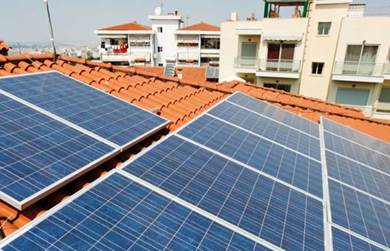Description

Disclaimer: Copyright infringement not intended.
Context
- The Rooftop Solar Programme has been extended till 31.03.2026 and therefore, subsidy under the programme will be available until the target under the Programme is achieved.
Solar Rooftop System
- In a solar rooftop system, solar panels are installed inside the system for electricity production. This solar panel produces energy which can be used for different purposes.
- One of the great benefits of this system is that it takes less space and produces efficient energy for multiple usages.
How does it work?
- Solar technologies absorb the Sun’s radiation and turn it into energy. When the sun shines onto a solar panel, the photovoltaics (PV) cells in the panel absorb the sunlight, helping in the creation of electric current. A rooftop solar plant refers to one where the solar panels are mounted on top of a residential or commercial building.
Pros
- Cost savings: It is cheaper than the conventional electric supply and government subsidies also help bring the cost down.
- Low maintenance charges: Most rooftop solar systems have a life expectancy of up to 25 years and require only basic maintenance such as regular cleaning and repairs.
- No additional land is required as vacant rooftop space can be utilised for installing solar panels.
- Reduction in carbon footprint: Solar is a clean and renewable source of energy that helps in cutting the emission of greenhouse gases.
Cons
- Solar panels are not suitable for every type of roof. For instance, it could be difficult to set them up on slate or cedar tiles used in old houses.
- Since solar is a big financial investment, it may not be an ideal choice for young homeowners who could be moving in the coming years.
Solar rooftop subsidy scheme
- Solar rooftop subsidy scheme is an initiative by the Government of India to promote solar rooftop usage in the country. The central government through the solar rooftop subsidy yojana encourages use of renewable energy and provides subsidies on solar rooftop installations to consumers.
- The process for installation of rooftop solar plants will start from registering applications and then releasing the subsidy in residential consumers' (beneficiaries') bank accounts after installation and inspection of the plant which can be tracked online at the national portal.
.jpg)
Subsidy paid in the solar rooftop subsidy scheme
- The central government pays a 30% subsidy for installation of rooftop solar plants to states in general categories.
- For special states such as Himachal Pradesh, Uttarakhand, Sikkim, Jammu & Kashmir and Lakshadweep, the central government gives subsidies of up to 70%.
Classification of subsidies:
- Up to 3 kW capacity - 40%
- 4-10 kW capacity - 20%
- Above 10 kW - No subsidy
- In the case of GHS/RWA consumers, there is a subsidy provision of 20% for a total capacity up to 500 kWp (limited to 10 kWp per house).
Solar Rooftop Calculator
- The solar rooftop online calculator helps to get an estimate of small power plant installations using solar in your premises. It is a calculator for installing rooftop solar panels based on one’s budget or available space or KW required.
Closing Thought
- India had target to install 40GW solar panels at residentail home buildings, but India has achived only 5GW till 2021. Indian Goverment has set the target of 280GW solar panels by 2030 that means, every year India needs to install 10GW every year.
.jpg)
https://economictimes.indiatimes.com/industry/renewables/government-extends-rooftop-solar-programme-till-march-2026/articleshow/96091604.cms






.jpg)








